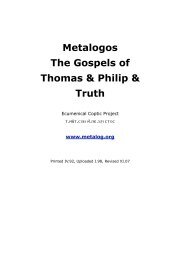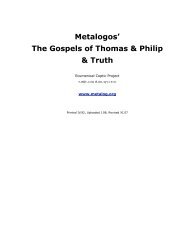Andrew Louth - Syriac Christian Church
Andrew Louth - Syriac Christian Church
Andrew Louth - Syriac Christian Church
You also want an ePaper? Increase the reach of your titles
YUMPU automatically turns print PDFs into web optimized ePapers that Google loves.
137 Cf. Denys the Areopagite, Divine Names II.11; IV.7, 10, 14; X.1.<br />
138 Cf. the teaching in Ep. 2, above, esp. 396A (p.86).<br />
DIFFICULTY 41<br />
1 There is a translation of most of this Difficulty (all apart from the final<br />
contemplation) in Hausherr (1952), 164–70, which I have found helpful.<br />
2 From St Gregory Nazianzen’s Sermon 39.13, on the Feast of Lights (i.e.,<br />
the Theophany, or Epiphany) (PG 36.348D).<br />
3 For these divisions, cf. Gregory of Nyssa, Contra Eunomium I.270–2, III.<br />
6.62–7 (Jaeger [1960], 1.105–6, 2.66–7), and elsewhere, and the<br />
discussion above, Introduction, chapter 5. Amb. 10.26, above, also<br />
develops the notion of the divisions of being and alludes to similar texts<br />
in Gregory of Nyssa.<br />
4 See Gregory of Nyssa, On human creation 2 (PG 44:133A).<br />
5 Syndesmos: a key term in Maximus’ theology, used by Nemesius, On<br />
human nature 1 (Morani [1987], 5).<br />
6 Diastêma: another key term of Maximus’.<br />
7 Cf. Gregory of Nyssa, On human creation 16 (PG 44:181 AB).<br />
8 It sounds odd to refer to the human person as ‘it’, but Maximus is<br />
talking about a human person transcending sexual differentiation,<br />
which would be obscured by the use of ‘he’ or ‘she’.<br />
9 Cf. Gregory of Nyssa, On human creation 17 (PG 44:189A and D), and<br />
frequently elsewhere.<br />
10 Perichôrêsas: used also in the Greek tradition to express the<br />
interpenetration of the natures of Christ, and the Persons of the Trinity<br />
(cf. Latin: circumincessio).<br />
11 Cf. Gregory of Nyssa, On human creation 17, 22 (PG 44:189AB, 205A).<br />
12 Reading timiôtata, not atimiôtata. See Hausherr (1952), 169n.<br />
13 Denys the Areopagite, Divine Names 13.2 (980A).<br />
DIFFICULTY 71<br />
NOTES 211<br />
1 Last lines of Gerard Manley Hopkins’ sonnet, ‘As kingfishers catch fire’.<br />
2 From the poems of St Gregory of Nazianzus, To the Virgins 2(PG 37:<br />
624). There is a critical text neither of Maximus nor of Gregory’s poems:<br />
I have translated what seems to me the most plausible reading.<br />
3 ‘Prudence’: phronêsis, which I have usually translated ‘sagacity’, but<br />
here the opposition with play suggests prudence (the usual Latin<br />
translation of phronêsis being prudentia).<br />
4 Maximus here is using the technical language of apophatic and<br />
cataphatic theology, first found among <strong>Christian</strong>s in Denys the<br />
Areopagite: ‘negation’ translates apophasis and ‘affirmation’ kataphasis.<br />
5 Maximus underlines here and several times later the conjectural quality<br />
of his reflections here (the word he uses is stochastikôs).<br />
6 See the previous note.




